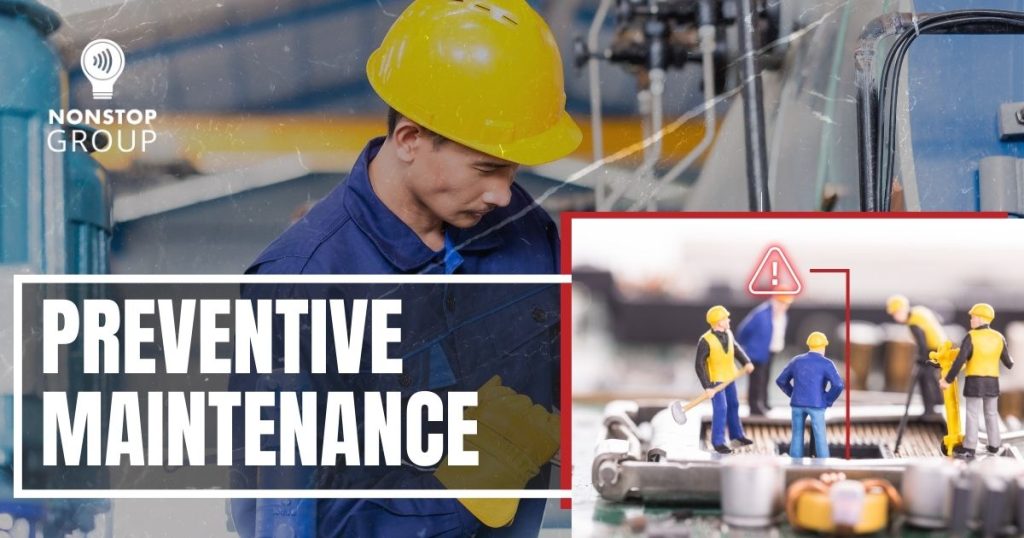6 Min Read

In industrial operations, preventive maintenance emerges as the cornerstone for the smooth operation of equipment and machinery.
This proactive maintenance strategy starkly differs from the reactive approach of waiting for failures to occur before addressing them. Instead, PMS aims to identify and resolve potential issues before they snowball into major problems. Consequently, organizations can save significant resources that would otherwise be spent on costly repairs or replacements—all while minimizing unplanned downtime, thus optimizing productivity.
Due to its significant advantages, almost 88% of manufacturing organizations implement preventive maintenance. Within this group, 40% of businesses utilize advanced analytics tools, while 22% utilize operational data analysis to improve their maintenance strategies further.
This exhaustive guide discusses the critical aspects of preventive maintenance and its pivotal role in optimizing operational efficiency and maximizing asset performance. Let’s dig in!
What is PMS Preventive Maintenance?
PMS, or Preventive Maintenance System, involves a proactive strategy in managing maintenance to prevent potential asset or equipment breakdowns beforehand. The goal here is to minimize the risk of unexpected breakdowns, decrease downtime, and extend the lifespan of equipment. In fact, a study by Jones Lang LaSalle shows that a well-planned preventive maintenance plan results in an average 545% return on investment (ROI).
In a PMS, maintenance tasks are scheduled based on factors such as equipment manufacturer recommendations, historical performance data, and regulatory requirements. These tasks include routine PM inspections, lubrication, calibration, parts replacement, and other proactive measures to keep equipment running smoothly. By implementing a preventive maintenance program, organizations can avoid costly downtime, improve reliability, and optimize asset performance.
Typically, a preventive maintenance checklist entails the following key essentials:
- Schedule Maintenance: Each preventive maintenance task is scheduled based on manufacturer recommendations, operational requirements, and historical performance data.
- Inspections:Equipment and machinery are regularly inspected for wear and tear, damage, or other potential issues that could lead to failure.
- Cleaning and Lubrication: Asset components are cleaned and lubricated as needed to keep them operating smoothly.
- Testing and Calibration: Critical equipment may be calibrated to ensure it operates within specified parameters.
- Replacement of Parts: Worn or damaged parts are replaced before they fail.
- Documentation: All preventive maintenance activities are documented, including inspection results, repairs performed, and parts replaced.
Preventive Maintenance Examples
In asset-heavy industries, preventive maintenance is essential for the uninterrupted operation of critical machinery. For instance, in manufacturing, regular inspections and lubrication of production equipment prevent breakdowns and maintain efficiency.
In the automotive industry, scheduled maintenance such as oil changes and tire rotations keep vehicles running smoothly. Thus reducing the risk of unexpected failures. Similarly, in the energy sector, power plants conduct routine maintenance checks and servicing of turbines and generators to prevent costly outages.
Pro Tip
Take advantage of The NonStop Suite’s mobile accessibility features. This modern asset management software enables your organization to access preventive maintenance schedules, tasks, and data from anywhere, at any time. Thus, your maintenance team can respond swiftly to maintenance needs, enhancing efficiency and minimizing disruptions to operations.
Smarter Asset Tracking With NFC Tags
Learn more about how NonStop Suite's NFC Asset Tracking Solution can help your Enterprise streamline operations to new heights.
Get A Free Product Tour
What are The 4 Types of Maintenance Strategies?
In industrial operations, maintenance strategies can be broadly categorized into four distinct types. Each plan features a unique approach to managing and sustaining the functionality of equipment, machinery, or systems.
Detailed below are the 4 common types of maintenance strategies employed in industrial and organizational settings:
Reactive Maintenance
Also known as “breakdown maintenance,” this strategy involves addressing equipment failures as they occur. Repairs are conducted only after a piece of equipment has malfunctioned or failed. This corrective approach to maintenance mainly results in unplanned downtime and potentially higher repair costs due to emergency response requirements.
Preventive Maintenance
This proactive approach entails regularly scheduled inspections, servicing, and component replacements to prevent equipment failures before they occur. Following the PMS strategy, facility managers adhere to predetermined maintenance schedules based on equipment manufacturer recommendations or historical performance data. As a result, organizations can cut down on unexpected downtime and extend the lifespan of assets.
Condition-Based Maintenance
Similar to predictive maintenance, condition-based maintenance relies on real-time monitoring of equipment conditions to inform maintenance decisions. By continuously assessing key parameters such as temperature, vibration, and fluid levels, organizations can determine the optimal time for maintenance activities. Consequently, optimizing resource allocation and minimizing unnecessary downtime.
Reliability-Centered Maintenance (RCM)
Rooted in the analysis of equipment reliability and risk, RCM prioritizes maintenance tasks based on their impact on system performance and safety. By identifying critical components and failure modes, RCM enables organizations to allocate resources efficiently. This maintenance strategy focuses on the maintenance activities that yield the greatest return on investment in terms of reliability and operational integrity.
Pro Tip
Integrate The NonStop Suite into your maintenance strategy to gather real-time data on asset performance and health. Connecting NFC asset tags and smart asset management capabilities lets your organization monitor equipment conditions remotely and receive instant alerts about potential issues. Ultimately, this enables proactive maintenance actions to be taken promptly.
What's The Difference Between Preventive Maintenance and Predictive Maintenance?
Preventive and predictive maintenance share the common goal of preventing breakdowns, minimizing downtime, and optimizing asset performance. However, despite their apparent similarity, they represent distinct methods for asset maintenance.
Here’s a thorough comparison of these two strategies, highlighting their key differences across different aspects.
Preventive Maintenance Vs Predictive Maintenance | ||
Aspect | Preventive Maintenance | Predictive Maintenance |
Definition | Regularly scheduled maintenance tasks aimed at preventing breakdowns and preserving equipment functionality. | As one of the main types of preventive maintenance, predictive maintenance uses data and analytics to predict when equipment is likely to fail so that maintenance can be performed just in time. |
Schedule | Maintenance activities are performed at predetermined intervals, regardless of equipment condition. | Maintenance activities are scheduled based on the actual condition of the equipment, as indicated by data analysis. |
Approach | Calendar-based or usage-based schedule. Maintenance is performed at regular intervals. | A data-driven approach using real-time or historical data to detect patterns and anomalies that indicate potential failures. |
Data Usage | Relies on historical maintenance records and manufacturer recommendations. | Relies on real-time or historical data from sensors, monitors, and other sources. |
Objective | Prevent unexpected failures and extend equipment lifespan by addressing potential issues before they cause downtime. | As one of the main types of preventive maintenance, predictive maintenance uses data and analytics to predict when equipment is likely to fail so that maintenance can be performed just in time. |
Why Do You Need a Preventive Maintenance Schedule?
A well-planned preventive maintenance schedule ensures the optimal functioning and longevity of machinery, equipment, and systems. By adhering to a preventative maintenance routine, potential problems can be identified and resolved proactively before they escalate into costly breakdowns. This proactive approach minimizes downtime, increases operational efficiency, and extends the lifespan of assets. Ultimately reducing overall maintenance costs.
Below are some of the most prominent reasons why a preventive maintenance schedule is essential for your organization:
- Increased Equipment Reliability: Regular maintenance helps identify and resolve issues before they escalate into costly breakdowns. This proactive approach minimizes unexpected downtime, ensuring that equipment remains operational when needed.
- Extended Equipment Lifespan: Regular maintenance prolongs the lifespan of equipment by addressing wear and tear, lubrication needs, and other factors contributing to deterioration over time. This can save significant costs associated with premature replacement.
- Cost Savings: Preventive maintenance is typically more cost-effective than reactive maintenance. By pinpointing issues early on, your organization can subside expensive repairs and replacements, as well as minimize the impact of downtime on productivity and revenue.
- Improved Safety: Regular maintenance helps ensure equipment operates safely, eliminating the risk of accidents or injuries caused by malfunctioning machinery. This is particularly important in industries where safety is a top priority.
- Compliance with Regulations: Many industries have regulations and standards that require regular equipment maintenance to ensure safety, environmental compliance, and quality control. Following a preventive maintenance schedule helps businesses meet these requirements.
- Optimized Performance: Well-maintained equipment tends to perform better, delivering consistent results and minimizing variations in output. This efficacy results in improved product quality and customer satisfaction.
- Predictive Insights: Over time, data collected during maintenance activities can provide valuable insights into equipment performance and reliability. This data can be used to identify trends, predict future maintenance needs, and optimize maintenance schedules for maximum efficiency.
PRO TIP
Incorporate The NonStop Suite to schedule preventive inspections and maintenance of your organization’s assets. With The NonStop Suite’s advanced data reporting and auditing capabilities, your organization can stay proactive with maintenance checks. Ultimately, it prevents costly downtime or failures and optimizes asset performance.
When Do You Need Preventive Maintenance?
Preventive maintenance is critical to ensure organizational assets remain in optimal condition and function efficiently. Not only does it help enhance equipment reliability and safety, but it also ensures compliance and cost-effectiveness. Put simply, organizations can minimize the risk of unexpected failure by implementing a proactive maintenance program.
Here are some situations in which preventive maintenance is typically needed:
- Scheduled Intervals: Many machines and equipment require preventative maintenance at regular intervals, such as monthly, quarterly, semi-annually, or annually. The frequency lies in factors like usage, manufacturer recommendations, and industry standards.
- Manufacturer Recommendations: Manufacturers provide guidelines and schedules for preventive maintenance in their product manuals or documentation. Adhering to these recommendations can prolong the lifespan of the equipment and maintain its warranty coverage.
- Critical Systems: Systems critical to operations, safety, or compliance mostly require preventive maintenance to minimize the risk of unexpected failures. This includes HVAC systems, electrical systems, fire suppression systems, and production machinery.
- High-Usage Equipment: Equipment that experiences heavy usage or operates in demanding environments may require more frequent preventive maintenance. Implementing a PMS strategy can help prevent wear and tear, reduce downtime, and avoid costly repairs.
- Seasonal Changes: Some equipment requires specific maintenance tasks before or after seasonal changes to ensure optimal performance. For instance, HVAC systems may need maintenance before the beginning of the summer or winter seasons.
- Environmental Factors: Equipment operating in harsh or corrosive environments, such as industrial facilities or outdoor installations, need frequent maintenance to prevent deterioration and ensure safety.
- Regulatory Compliance: Certain industries, such as healthcare, aviation, and manufacturing, are subject to regulatory requirements mandating regular inspections and maintenance. This will help ensure safety, quality, and compliance with industry standards.
- Predictive Maintenance Data: Utilizing data from predictive maintenance technologies can help identify issues before they snowball into costly equipment failure. Consequently, prompting timely preventive maintenance actions.
Conclusion:
A preventive maintenance plan significantly enhances the efficiency, reliability, and longevity of equipment and systems. To help your organization establish preventive maintenance programs, The NonStop Group brings a modern and innovative preventive maintenance software—The NonStop Suite!
Take the next step in optimizing your organization’s preventive maintenance strategy by leveraging the capabilities of The Nonstop Suite. With its advanced technological features and user-friendly interface, The Nonstop Suite offers a comprehensive solution for implementing and managing preventive maintenance practices. From scheduling routine inspections to tracking maintenance history and analyzing performance data, Nonstop empowers your organization to streamline maintenance processes.
Start building a proactive maintenance culture today with the help of The NonStop Group. Schedule a FREE personalized product demo today and unlock new levels of efficiency, reliability, and profitability for your organization.

